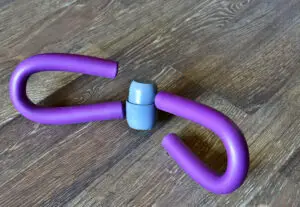If a regular press up is not hard enough for you, why not take it to the next level with an elevated version? The press up, or push up, is one of those classic exercises that just about everyone will incorporate into their workouts because it offers so many benefits.
The typical press up works your chest, arms, shoulders, and back, with some benefit to the legs as well since they are providing support and balance.
Let’s look at the elevated modification of the traditional press up, though, and see how it is different and how it can be used to improve your gains and your workout.
What Is a Feet Elevated Press Up?
This version of the push up uses an elevated position that places your feet on a higher surface than your hands. That stance pushes your upper body down harder with the force of gravity, making you work harder to push yourself up to the full height of your arms when they are completely extended.
It means you have to exert more force from your shoulders, upper arms, and forearms.
In theory, it should give you greater gains, but it is not a push up that everyone will be able to do. This is the kind of exercise you move to when you want a greater challenge out of your workout.
How to Do a Feet Elevated Press Up
For this exercise, you will need to use an elevated surface. A workout bench or a box will work fine. If nothing else, you can use the seat of a chair. Just make sure that whatever you use is secured and will not slide out from under you when you start working out.
We recommend starting with a low elevation, because the higher your feet are elevated, the more force of gravity will be exerted on your upper body. That means you will have to do even more work to push yourself up.
Start by kneeling down by the bench or other elevated surface, with your back facing to it. Then, place your hands on the floor with your palms flat.
Your shoulders should be directly above your wrists and the elbows should be bent at a 45-degree angle. From that position, put your feet onto the bench.
Your legs and shoulders should be lined up as you start the exercise. Once you are in position, brace yourself with your quads, your glutes and your core. Bend out at the elbows and let your upper body lower to the floor. Your neck and head should remain straight as you do this.
Once your chest and nose almost touch the floor, you can push yourself back up to the starting position as you straighten your elbows once more.
You can do 8-15 reps and 2-3 sets for this exercise, but be careful about overdoing it. It can be an exercise that puts a lot of strain on your shoulders and wrists in particular, so if you feel pain there, you need to stop the exercise.
Make sure that your form is correct before you try again.
Consider building up your upper body power first if the feet elevated press up is giving you a lot of trouble.
If you have the wrong form for this exercise, you will injure yourself, making it difficult to continue your workout. If you want to make the workout easier, you can lower your elevation. You may want to increase the elevation over time to give yourself a greater challenge and improve your gains.
Tips:
- As you do the elevated press up, be aware of the line of your back. Make sure it does not arch, and you can tilt your pelvis back a bit to help keep the back in line. Your core and glutes can be used to keep the line of your back stabilized as well.
- To keep your neck in the right position (a neutral position), look down as you do the exercise rather than up. Your back and neck should stay lined up as you do this exercise.
- Watch your elbows as well. They should stay at a 45-degree angle when you are down at the bottom of the press up. If they flare out, then your shoulders can experience undue pressure and may be damaged.
What Muscles Does a Feet Elevated Press Up Work?
This exercise puts a lot more strain on your upper body, targeting the pectorals, shoulders and upper arms, primarily. These muscles have to work harder than they would when doing a traditional push up, so the gains to those muscles should be greater. That is true only if you can sustain this exercise for as long as you would a regular push up.
Your forearms are worked as well, as are some of your leg muscles and your core muscles. However, the focus is off the lower body even more with this modification, so you won’t get the kind of gains you normally would for the lower body and core body muscle groups. Push ups are not really about those muscles anyhow, but the elevated push up is even less beneficial to those muscles.
There are modifications of the elevated foot press up you can do that will target some of your muscles even more. If you would like to focus on your triceps, biceps, or your shoulders and chest, then try some of these variations:
Wider Stance
Placing your hands farther apart will put more of the exertion on the chest and shoulders, building those muscles faster.
Narrow Stance
Bringing your hands closer together when you do the elevated push up will activate your triceps more and improve gains for that muscle group.
Inward Stance
By rotating your forearms and wrists in toward each other as you do the feet elevated press up, you will put the focus more on your biceps. This can be quite a strain on your wrists in particular, so you will want to take this one carefully and stop doing it if it is very painful.
Benefits of a Feet Elevated Press Up
Some of the benefits of this push up modification are immediately evident. Your gains for the upper body muscles can be improved by using this push up instead of the traditional version. For that reason, it is certainly worth trying this exercise out every now and then.
If you want to build a powerful upper body quickly, challenging exercises like this are crucial to that goal. You can’t just do the same kinds of typical exercises that most people do just to get in shape.
Of course, the elevated press up is great for toning the body and getting your heart rate up, helping you to lose weight effectively. It offers practically all of the benefits of the typical push up but with added benefits to the upper body and an increase in upper body gains. The lower body suffers a bit as a result, but not significantly.
One of the great things about the elevated press up is that it uses gravity to increase gains rather than incorporate expensive gym equipment or some other type of tool. That makes it a very versatile exercise that can be done practically anywhere at any time. You just need the appropriate elevation to make it work.
My name is Ellis Francis and I have been a personal fitness trainer, sports nutritionalist and health and fitness advisor for over 25 years. I am the lead health and fitness advisor at https://awellnessbody.com.







